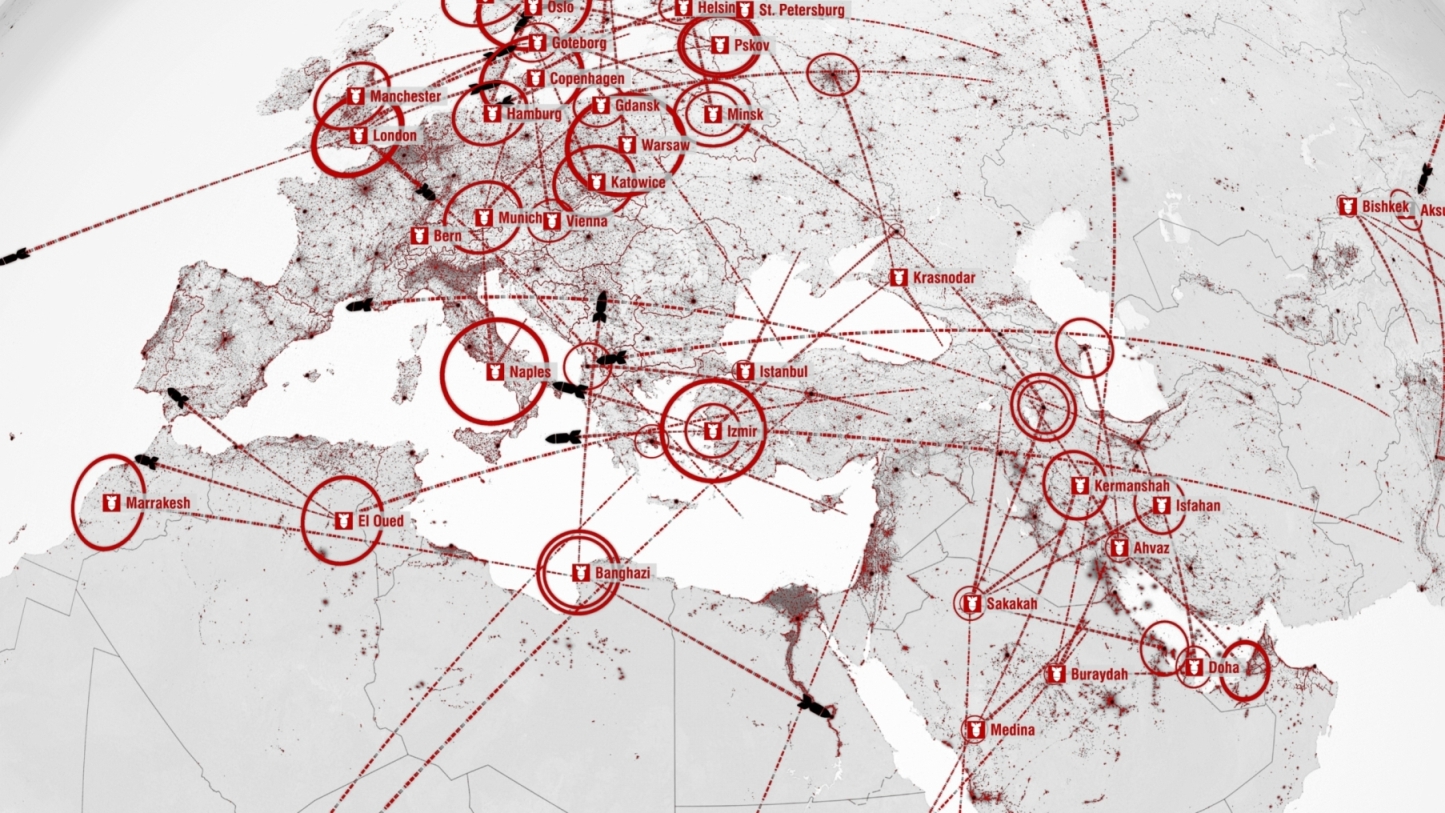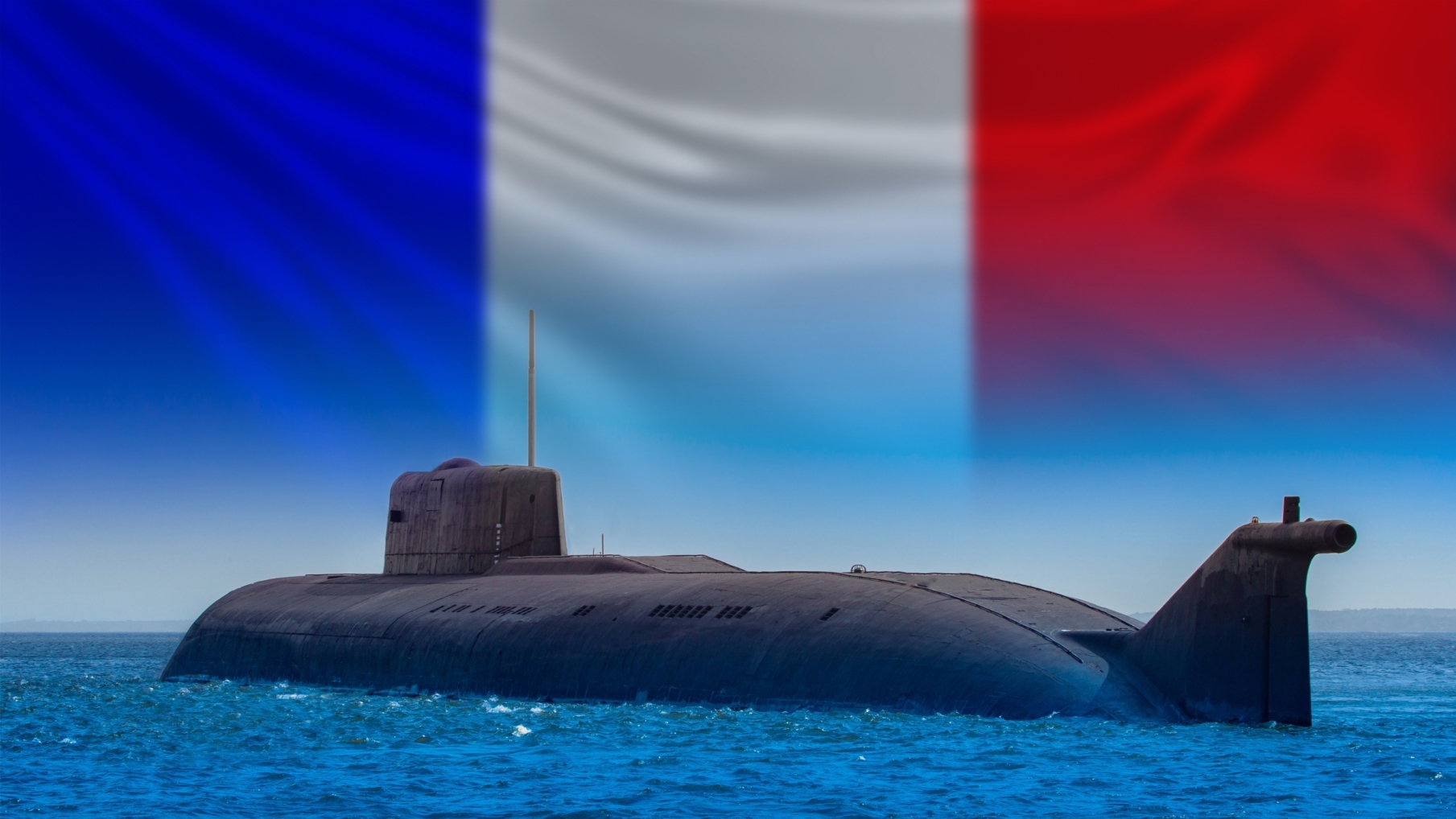Abstract: The decline of the US nuclear security guarantees is concerning. Since the 1960s, the US flexible response posture has been perceived as irrelevant and uncertain. However, a turning point emerged during the Georgian conflict of 2008, which exacerbated the destabilization of European security in the 2014 Crimean crisis. Too alarmed by a recurrence of menacing periods, European leaders have thus been compelled to conceive a new European security and defense architecture. Conventional armies cannot withstand any overwhelming Russian capabilities, which points to a nuclear arsenal to strike a balance of unbalance. Different schemes have been proposed and dismissed, resulting in the “Dissuasion concertée”. The seemingly French version of extended deterrence is a valuable initiative that was bolstered on February 7, 2020, as an offer for nuclear deterrence to all of Europe.
Problem statement: How to constructively reconsider the balance of power in Europe in the context of sharp shifting detrimental power combined with elusive US nuclear power?
Bottom-line-up-front: This paper explores the prospects of establishing common nuclear forces in Europe for current to mid-term periods. It may be necessary given the declining NATO guarantee security system.
So what?: An examination of the functioning US nuclear protection for its European allies shows it stands out from the national experiences of nuclear-armed states. Incidentally, this essay’s two pillars shed light on the new geostrategic framework of European security for coming decades, should the balance of unbalances in this area collapse, including a remaining US security guarantee.

Source: shutterstock.com/Trzmiel
European Nuclear Deterrence through NATO
Although some French observers claim that the objectives and goals of the French Force de dissuasion were initially conceived to serve European and Atlantic Alliance security purposes, as evidenced by France, a member of NATO, which monopolized the nuclear deterrent to the Anglo-Saxons; the reality is quite the opposite[1]. The force de frappe stems from facts and historical episodes, beginning with the US-Soviet responses to the 1956 Suez crisis. This was exacerbated by the blunt denial of US military support for France in its fight against Algerian resistance fighters, which Washington claimed was outside the area of the North Atlantic treaty[2].
This paper seeks to unfold the scope and the strategic acceptance by the Atlantic Alliance of the notion of a “European pillar”, short of proper strategic autonomy in Europe in the field of defense and security for European allies. On the one hand, you have the independent Euro, whereas deterrence is on the other. Fearing being sidelined by the Americans and wearily suspecting this nuclear condominium ‘being established, following the emergence of the detente between the two superpowers, some European allies were eyeing the Soviet Union positively, including France in the European missiles crisis in the 70’s. As one of my former French professors put it, “the Europeans like Arabs didn’t coalesce until they were seriously faced with an imminent threat[3]. It ensued unanimously a consent amidst European allies, including France, with President Francois Mitterrand turning the attention towards “the missiles at the East and the Pacifists at the West.” Due to this dynamic change, France’s rhetoric continuously repeats. The Force de Dissuasion which serves the vital interests of the country did switch to incorporate the surrounding environment vaguely with materially producing medium-nuclear missiles (MRBM) like Pluton and Hades. Skirting its everlasting nuclear doctrine, it declared that a warning Salvo would be fired if need be. With the reunification of Germany and its re-emergence as a proto-power in Europe, France was challenged and the latter scrambled to offer its nuclear umbrella ambiguously with the formula of “Dissuasion concertée”. Later, France was thrilled to substitute its nuclear umbrella for US/NATO security guarantees.
The missiles at the East and the Pacifists at the West.
The US Extended Deterrence and Western European Allies
The concept of deterrence is as old as humankind and can be dated back to Hammourabi’s Code. However, according to the French analyst Pascal Boniface, today’s situation sharply differs, as nuclear deterrence is perceived as strategic coercion. It entails a state’s ability to intimidate an adversary from resorting to military force by positing that the costs incurring from such a course of action will overwhelm the potential gains while also excluding shimmering diplomatic coercion, a policy highlighted by the US Thomas Schelling and termed “sanctuarization aggressive” by the French Jean-Louis Gergorin[4]. The notion of rationality is at center stage, as underlined by the US nuclear expert Keith Payne, according to whom deterrence could be approached as “an arcane psychosocial art involving a mosaic of adversary design makers, circumstances, uncertainty, and error”. In the same vein and theoretically put, John Mearsheimer stresses that deterrence “is most likely to occur when an attacker believes that his probability of success is low, and the costs will be high.”[5] Much more convincing and relatively well-founded is the rationale that with this revolution in military affairs, any adversary could presume that victory is possible, as they are aware of the mutual deterrence, which is logically compelling. More bluntly, the primary restraint between the protagonists of nuclear competition is challenging as they possess a secure second-strike capability, performed – according to nuclear experts – by actual submarine-launched ballistic missiles, consequently leading to Mutual Assured Destruction (MAD)[6].
As far an extended US deterrence is concerned in Europe, we should expect to address three actors – the two superpowers and allied Europe – presumably in a mere complex equation that was the case with the MAD of the Soviet Union and the US. Extended deterrence means that a protector pledges to resort to using nuclear weapons against a hypothetical aggressor to deter it from employing military force, whether conventional or nuclear, against its ally. As some observers argue, extended nuclear deterrence was conceived to “protect other countries and territories from attack, distinct from preventing a direct attack on one’s territory.”[7]
Extended deterrence means that a protector pledges to resort to using nuclear weapons against a hypothetical aggressor to deter it from employing military force, whether conventional or nuclear, against its ally.
The US Extended nuclear deterrence cannot be considered straightforward if it principally relates to the US nuclear arsenal scattered throughout European states, given that charting a strategic coupling between homeland America and Europe is necessary. Indeed, the general sense of extended nuclear deterrence implies channeling declaratory policy and messages while unequivocal assurances, exemplified as specific security guarantees, are provided through formal alliance agreements. Focusing on the psychological segment of extended nuclear deterrence is constructive as it is more challenging to achieve than with a dyadic deterrence relationship. Incidentally, the nuclear guarantees provided to European NATO allies are a crucial element in any assessment of the credibility of the US nuclear umbrella. As Thomas Schelling noted, “the difference between the national homeland and everything” abroad’ is the difference between threats that must be credible. It requires protecting intentions. It requires having those intentions… and communicating them persuasively to make other countries behave[8].
In the aftermath of the ‘60s US-Soviet rapprochement and the start of negotiations to adopt the treaty on non-proliferation, Washington deemed it necessary to broaden in a nuclear sense – sharing the decision-making process within NATO’s multilateral structure to gain trust and confidence from European allies. In that respect, the attitude of President Charles De Gaulle conveyed that the European NATO members could not spare France’s “contagion” of strategic independence in alleviating any involvement with the risks and responsibilities incurred by the US nuclear arsenal.
NATO Nuclear Sharing Arrangements and European Allies
Before institutionalizing NATO consultative arrangements with European allies, the US in the early 1950s engaged in the deployment of tactical nuclear weapons (gravity bombs) to the United Kingdom[9]. The US believed the Allies could not defend themselves against a Soviet attack[10]. The idea of delivering nuclear weapons to European allies was rooted in the conviction that the Soviet Union could launch a conventional attack and overrun NATO in Europe. These apprehensions and attacks around the scope of the Soviet Union’s “capabilities have been reportedly mentioned in a Central Intelligence Agency (CIA) report, which presumed that the USSR had and through mid-1954 would probably have the military strength to pose a constant and severe threat to the security of NATO allies[11]. Although the Americans expressed their stark resolve sharply to secure their European allies through the announcement of a new nuclear posture, dubbed the “massive retaliation” doctrine; the French were not impressed. They instead launched their military nuclear program in the mid-1950s, ending up with the Gerboise Bleue test in Algeria[12]. Although the Russians had started building their nuclear arsenal, they could not afford to challenge the West, as was highlighted later by the Berlin crisis[13]. Following the improvement of Russian military capabilities that challenged Europe’s NATO security, the Kennedy Administration demonstrated a firm willingness to deliver nuclear medium-range and intermediate-range ballistic missiles to Europe, expecting to restore the balance of power.
The idea of delivering nuclear weapons to European allies was rooted in the conviction that the Soviet Union could launch a conventional attack and overrun NATO in Europe.
Resulting from the geostrategic dynamics in the US-Soviet rivalry, an unprecedented crisis emerged in the Atlantic Alliance, shaping further developments. It was primarily due to NATO’s adoption of the “flexible response” posture, which introduced a sort of atomic condominium between the two superpowers and consequently prioritized their supreme interests over their allies[14].
When addressing the trend involving the uncertainties as to whether the US nuclear Umbrella unfolded enough to cover the Alliance partners effectively or not. As a first step, one must outline the nuclear doctrine at the core of the crisis and its broader implications within non-nuclear and nuclear-armed European countries. The aim is to figure out the arguments and the contending views of the nuclear protector and protected allies. With the prospect of easing arising claims related to nuclear sharing and broadly neutralizing any schism, the Kennedy Administration came up with the idea of associating the European allies with nuclear decision-making mechanisms. Such opportunities offered by the USA to NATO allies occurred through prominent nuclear forces projects, such as the Multilateral Force (MLF) and the Atlantic Nuclear Force (ANF) formulas[15].
With the prospect of easing arising claims related to nuclear sharing and broadly neutralizing any schism, the Kennedy Administration came up with the idea of associating the European allies with nuclear decision-making mechanisms.
The geostrategic context in Europe was a key driver of the emergence of the US nuclear-sharing framework. Conversely, the sustaining claims of a European nuclear deterrent were bound to fail primarily because of French and US opposition to centrality in nuclear decision-making. These are “transatlantic misunderstandings,” as Henry Kissinger noted in his famous book[16]. Kissinger’s work laid the foundations essential to comprehending the debate on establishing an independent European nuclear force and the well-founded distrust the European allies expressed towards the US through NATO. Ideally, the intent of programming the deployment of nuclear forces on the NATO European territories during the early stages of the cold war started in the 1950s. The underlying rationale was to contribute to restoring and addressing the military and strategic imbalances that had emerged in the continent due to a perception of overwhelming Soviet strength. The MLF formula proposal was a by-product of the US’s willingness to curb any soviet invasion of its European allies and to reassure them about their security for the future. This trend heralded extended deterrence, and consequently, sharing in nuclear responsibilities was deemed necessary for partners prone to uncertainties.
The MLF proposal dates back to 1957 as a US offer designed to strengthen NATO military forces with advanced intermediate-range ballistic missiles produced and delivered to NATO members that requested them. The military code of conduct (MC 70), worked out under the aegis of the Supreme Allied Commander in Europe, General Nordstadt, was designed to fill the gap in firepower in aid of Western Europe allies facing the Soviet Union. In this framework, it was suggested that the allies should control the delivery systems while the USA maintained its grasp over the nuclear warheads. With the lethal military capabilities fielded, General Nordstadt concluded that they might be employed in any conflict in central Europe should the conventional capabilities prove inefficient and unable to roll back any overwhelming Soviet attack. Meanwhile, the US protector could consider resorting to an all-out war if necessary.
Countries like Italy, the United Kingdom, and Turkey were crucial candidates to host IRBMs, as was formulated in agreements with the latter. Nevertheless, the practical details concerning nuclear weapons remained distinct and were a matter of the country’s geography. Later, in 1959, General Nordstadt proposed an ambitious plan to broadly associate the NATO allies with the management of the nuclear issue and make the fourth power. Numerous MRBM and sea-based Polaris missiles were expected to be bought or produced by these partners under US licenses, to be deployed in European countries. Incidentally, the USA reserved the right to continue exercising control over the weapons[17].
In 1961, with the new US administration, President Kennedy sought to reassure European allies by pledging to broaden participation in the nuclear decision-making process in the Alliance. Against this background, he asserted in May 1961 that the USA was considering “setting” up a sea-based force of nuclear missiles, monitored by NATO, being multilateral both in ownership and control. This scheme was exceptionally available. If necessary, the allies would approve it, and the objectives regarding non-nuclear matters were effectively achieved. During the meetings of the NATO ministers in Athens, a decision was reached, stating that the USA assigned to NATO a force of submarine-launched missiles (SLBM), monitored by NATO’s Supreme Commander Atlantic (SACLANT). Finally, in 1962, following a meeting in Nassau (Bahamas), President Kennedy and British Prime Minister Harold Wilson agreed to create a Multilateral Force consisting of British and US nuclear submarines and a multilateral force made up of surface vessels and possibly Polaris missiles.
Against this background, he asserted in May 1961 that the USA was considering “setting” up a sea-based force of nuclear missiles, monitored by NATO, being multilateral both in ownership and control.
Structurally, a mixed team of European and US sailors was set at an operational level, whereas the North Atlantic structure would equip the fleet on the institutional level. From a political point of view, the team would be run by a committee bringing together all participating countries. As the –decision-making process was explicitly concerned with using these nuclear forces, the vote would need to be unanimous. Dismissed by France De Gaulle, the still-born MLF, even if endorsed by Netherlands and Italy, was held to be a reflection of dominance by the French leader and designed to link Europe to central nuclear decision-making permanently. With the demise of the MLF and an attempt to design a substitute framework, British Prime Minister Harold Wilson put forward a new formula for the nuclear issue to overcome the worries of European allies[18].
Designated the Atlantic Nuclear Force (ANF), its structure was subdivided into two strands. On the one hand, it suggested the creation of a multinational force comprised equally of British and US SLBM Polaris. On the other hand, a multilateral force was considered to create a fleet of surface vessels armed with Polaris as with the MLF but excluding British participation. The ANF would be dedicated to the defense of Europe, with arrangements to provide access to NATO’s European members in the planning and use of NATO nuclear capacities. Once again, France dismissed the ANF and gave up acting within NATO, with the consecutive consequence of a French withdrawal of the second formula. In the wake of the convulsion, Robert Mc Namara, then Secretary of Defense, proposed the creation of a selected nuclear Committee or Special Committee under the auspices of NATO, which sought to increase the degree of non-nuclear states’ influence over the software of existing nuclear arrangements. Later, this Committee was replaced by the NATO Nuclear Planning Group (NPG), established in December 1966 by NATO’s Defense Planning Group.
As a forum, all NATO member states except France attended biannual sessions of NPG. There, they had opportunities to check up and work out the nuclear policy of the Alliance and exchange points of view regarding the security of the continent. As a nuclear superpower, the USA was prone to lead NPG activities by planning prominent and critical roles and chairing the High-level Group (HLG), a consultative subsidiary authority. Moreover, the NPG was charged with issues related to US bombers’ deployments in European countries and consequently expanded its activities to members hosting such nuclear weapons. As exemplified, during their 8th yearly ministerial meeting in Ottawa, October 29 – 30, 1970, NATO nuclear planners addressed a set of nuclear issues. During this event, the NATO members had the opportunity to conduct political consultation around Alliance military doctrine, specifically nuclear doctrine, which was considered beyond “an exchange of diplomatic courtesies”[19]. Within the NPG’s activities, each ally could constructively assess the nuclear posture, criticize nuclear policy and consequently exercise its rightful privilege to shed influence on the doctrine.
As a nuclear superpower, the USA was prone to lead NPG activities by planning prominent and critical roles and chairing the High-level Group, a consultative subsidiary authority.
Through NPG gatherings, the ministers of defense could assess the balance of strategic forces and examine the dynamic shifts that impacted strategic nuclear capabilities. In October 1970, nuclear-related issues were reviewed, such as the situation of nuclear forces within the Alliance and the reliability of the flexible response nuclear posture. Additionally, ministers analyzed the military planning, upgraded the political guidelines related to the primary stages of the tactical nuclear weapons employment, and agreed on a policy dealing with the atomic demolition of ammunition (ADM). Understandably so, such allied consultations on nuclear issues where political and military considerations were closely interrelated could not be constructively possible until the creation of the NPG. It sufficed as a ‘software’ alternative to the “hardware” nuclear sharing schemes of the MLF and ANF. Since the introduction of the US nuclear delivery systems to Europe in the 1950s, some NATO members have been unsatisfied with their influence over political decision-making. By contrast, ambitious European allies, France being the most influential, has demanded genuine hardware control. This demand still comes to the forefront when considering the veracity of US nuclear guarantees.
The “Dissuasion Concertée” – French Initiative

Source: shutterstock.com/FOTOGRIN
The unprecedented change in the world following the collapse of the Soviet Union has significantly impacted European security and the threat perceptions of significant actors on the continent. It is against this backdrop that the new nuclear policy with the “Dissuasion concertée” should be understood, as the senior French officials realized that their influence should be poised to be restricted inside NATO European allies by opposition to Germany stretching out its might into traditionally favorable eastern Europe countries given its adverse consequences within the incipient European Union. Scholars accept that France’s endeavors to launch a unified plan at the outset of the 1950s were intentionally devoted to broadening its influence through this collective organization and exerting pressure on international affairs. With the dynamic change in the post-cold War period, French authorities might have thought that their Force de Dissuasion was an asset to be converted into politics and harnessed in international politics, specifically in a regional European balance of power. Why and what would this notion of a dissuasion concertée in this new geopolitical context in Europe look like?
With the dynamic change in the post-cold War period, French authorities might have thought that their Force de Dissuasion was an asset to be converted into politics and harnessed in international politics, specifically in a regional European balance of power.
The French secretary of defense, Jacques Mellick, employed the phrase “Dissuasion concertée” for the first time in 1992, noting that nuclear power still possesses its independence in nuclear decision-making while undertaking consultations with its nuclear partners in case it fires its nuclear capabilities[20]. The meaning suggests consultation or cooperation, and it is best understood when likened to the terminology of the league of nations “securité concertée” as an expression leaning toward “collective security” or even “collective deterrence” or “global deterrence”[21]. Notwithstanding Mellick’s definition of the term, the subsequent declarations of senior French officials in January and August / September 1995 shed insight on the significance of the “Dissuasion concertée”. At least in its initial format, as David S Yost noted, this phrase intersected with what he believed could be “deterrence supported by continuing consultations and substantive consensus”[22]. Following the unfriendly reaction of NATO’s European states to its proposal, French authorities were compelled to give more clarification on the actual purpose sought by the “Dissuasion concertée”.
The most obviously targeted country in these consultations was Germany, at least for historical and geographical reasons. In this respect, French foreign minister Alain Juppe had called for Germany to start discussions on certain aspects of nuclear issues, being more specific about this sort of deterrence proposed and excluding any hints of extended deterrence, which was more prone to hurt German perceptions as conducive to “paternalism”[23]. Despite their initial support of the initiative, the Germans notified the French authorities that the Force de Dissuasion should be consistent with NATO’s nuclear common pool basis. Beyond the governmental sphere, German public opinion dismissed the French initiative as impractical because of its incredibility and striking shortcomings[24]. What explains the German position was the fact that German officials might have worried about the repercussions of US disengagement. Berlin was not the only ally to be outspoken about consultative deterrence as the other European nuclear powers like the United Kingdom also disapproved of the initiative. The most notably expressed point of view from the government came from the then foreign secretary Malcolm Rifking, who in 1995 iterated that “if they wished to see their nuclear deterrent not simply as an atonal defense but as part of the wider defense of Europe, the conclusion would have been consistent with the British and US approach to nuclear weapons for the last fifty years”[25].
Paradoxically, these adverse reactions extended to France’s domestic politics. In this respect, some well-placed French observers were uneasy about formulating a European – only consultative nuclear-sharing arrangement as it had been seen as possibly harmful to French and European security. Thus, some French thinkers felt that the framework should not be intended to undermine US nuclear commitments to Europe[26]. Arguably, French involvement with its neighbours could alter the risks faced by France, a situation that could potentially worsen as the French leadership perspective aligned more with its allies[27]. As a result, European allies advised French authorities to confer with NATO’s NPG to overcome the complex issue of US nuclear commitments and to give “Dissuasion concertée” an opportunity to be seen as a constructive initiative. These European consultations were held in the late 1990s, a period marked by Russian withdrawal, too weak to be in a menacing financial crisis. The unfortunate events led the European allies to be thrilled.
French involvement with its neighbours could alter the risks faced by France, a situation that could potentially worsen as the French leadership perspective aligned more with its allies.
Consequently, their rejection of the consultative deterrence ensued, typically from prominent government-related critics of the United Kingdom and Germany. Well aware that their initiative was inappropriate, French officials realized that to build a European defense identity, they had to reconsider their project. To that end, they eyed the European Union as a reasonable alternative to the former project that aimed to insert a nuclear dimension. It was reportedly more convincing and possibly supported by the public opinion sensitive to the Russian menace and a challenging US withdrawal.
Towards a likely European Nuclear Deterrent
The advent of the European Union in 1993 featured the most appropriate framework to channel the French political and strategic objectives. This was more conducive to implementing a European defense strengthened by a nuclear dimension. Senior French officials believed that their nuclear capabilities could play a significant role in an assignment to protect the common vital interests of the European Union; even more, their country was committed through the stipulations in the Lisbon Treaty. French authorities might have discovered a niche with the Maastricht treaty, specifically through the common vital interests (CDSP). As the idealist channel, French authorities could be more convincing to their counterparts in asserting that the CDSP was the appropriate mechanism to achieve a European defense and move forward, overriding their nuclear deterrent in bolstering viable European security[28].
France’s 1994 White Paper (Livre Blanc) stressed that the issue of the European nuclear deterrent doctrine is becoming one of the major issues in building a common European defense. With the nuclear factor needed, the autonomy of Europe in defense would be possible. Nevertheless, there would be no nuclear doctrine or any European deterrence unless other partners regarded core European interests[29].
Previously, numerous statements by senior French officials conveyed that they had been seriously considering a proper European nuclear deterrent. This was highlighted by President Francois Mitterrand in 1992 when he urged the European members of NATO to consider the nuclear issue. The discussion surrounding the defense of Europe was fraught with unresolved problems still to be settled. In that regard, is it possible to design a European doctrine? This issue will soon be of the major questions related to the common European defense. President Mitterrand was more emphatic about the French nuclear posture in the wake of the cold war when asked about the status of nuclear capabilities: He stressed “can we manage the nuclear status within the European Union?”
Can we manage the nuclear status within the European Union?
Currently, except for Poland and France, most European countries have lost interest in any scheme of Europeanisation of nuclear deterrence, in stark opposition to other allies who prioritize adherence to US nuclear commitments. A set of considerations have underlined this longstanding option. Among these, the most significant disincentive for European countries to avoid the French or British nuclear arsenals is the perception that only nuclear capabilities comparable in size to Russia’s (those of the USA) would reliably balance Moscow’s forces and protect Europe[30]. This conception remains valid in most NATO and EU countries, specifically in Germany, where the members of the German parliament insisted on incorporating in the Preamble of the Aachen treaty constant security guarantees of NATO. Some observers argue that the reintegration of France into NATO is proof of its failure to mobilize European states towards a genuine European nuclear deterrent and the necessity for Paris to access the US and NATO-owned electronic early warning infrastructure[31].
Furthermore, France will need the Atlantic Alliance to cope with any looming nuclear crisis with Russia. Indeed, the 2014 Crimean crisis seriously impeded the French nuclear posture vis-a-vis its European partners. Another key driver favorable to the re-emergence of a European – only nuclear deterrent with French leadership is the uncertainty that surfaced with the Trump Administration pressing the European nations to alleviate the burden born by the US largely. Although the operationalization of the European nuclear deterrent seems illusory, the current strain on European security is favorable to such an idea due to the fear of a lack of interest vis-a-vis NATO. It is further aggravated by an enduring Russian threat, combined with the insignificant military capabilities of most European allies. France’s new doctrinal posture of extending its nuclear umbrella to its nuclear counterparts has become increasingly relevant.
Although the operationalization of the European nuclear deterrent seems illusory, the current strain on European security is favorable to such an idea due to the fear of a lack of interest vis-a-vis NATO.
Understandably, Macron might have sought to attract the attention of the allies, specifically with the European strategic autonomy project now underway, when delivering his speech at the Ecole Militaire on February 7, 2020, where he offered a “nuclear deterrent to all Europe.” In doing so, Macron highlighted the interrelation between France’s and Europe’s defense strategy with this current strategic framework, stressing that France’s vital interests have developed into a European dimension. He added with an ipso facto French nuclear umbrella that France’s nuclear capabilities would strengthen Europe’s security through their existence[32]. This potential extension to European allies could be a viable option, particularly if a US withdrawal would sideline Europe in favor of Asia.
Dr. Driss Larafi, the previous Head of the Department of law and Politics at the University College (Faculty of law, Ibn Tofail). currently teaches there. He was also a lecturer at the Royal College of Higher Military Studies, Kenitra in Morocco. He is an independent military specialist in Nuclear policy, international security, and International Humanitarian Law. His Ph.D. from Paris X Nanterre was centered around the nuclear arms race in the Mediterranean basin. His articles have been showcased in numerous journals and newspapers. Dr. Larafi’s commentary and interviews have been published by leading outlets like the Bulletin of the Atomic Scientists and Moroccan broadcasting corporation. His recent article “Hiroshima et l’inutilité de apocalypse nucléaire” was published in the Echos (French newspaper) in December 2018; and in The Treaty on the prohibition of the nuclear weapons in legal studies and judicial issues (Journal) in December 2020, pp 75-89. His current efforts are in a forthcoming book dealing with “North Korea and crippling nuclear order”. The views contained in this article are the author’s alone.
[1] Barthélémy Courmont and Pascal Boniface, Le monde nucléaire: Qu’est-ce qu’une concertation? (2007), Paris.
[2] Driss Larafi, (1990), op cit 25-151. For a thorough and comprehensive analysis of the french nuclear deterrent, see Marcel Duval and Dominique Mongin, (1993), « Chapter II : La IV Republique lance un programme atomique militaire (The IV political regime started an atomic-prone military program)», in Histoire des forces nucleaires francaises depuis 1955, Presses universitaires de France (PUF), 42 – 59.
[3] Through some of his explanations in a Master’s course, “Management crisis in the Global South,” Professor Jean-Pierre Colin, University Paris X Nanterre.
[4] Andrew O’Neil, (2013), Asia, the US, and Extended deterrence, Routledge, 13.
[5] Ibid., 7.
[6] Idem.
[7] Ibid., 11.
[8] Daniel Khaleesi, Strategic ambiguity: nuclear sharing and the secret strategy for drafting articles I and II of the NPT, The Non – proliferation Review, September – December 2015, Volume 22, number 3-4, The James Martin Center for non-proliferation studies, 423-428. It might be interesting to get the large developments devoted to that subject in my Ph.D. and related to the deployment of the VI fleet in the Eastern Mediterranean. I should point out that because of shortages compelled the USA to field their bombers in Morocco in 1948 (one caught fire for 48 hours with their hydrogen bombs) before being moved to Spain Franco in 1952. See C. Campell, ” Nuclear accidents in war Facts now, the weapons, systems,” The strategies, 1982, 231.
[9] Andrew O ‘ Neil, Asia, the US and extended deterrence, Routledge, 2013, 15.
[10] Daniel Khalessi, Strategic ambiguity: nuclear sharing and the security for drafting articles I and II of the NPT, 2015, 421.
[11] Ibid., 423. The Central Intelligence Agency (CIA) Report (1953) is the strength and capabilities of soviet Block forces to conduct military operations against NATO, October 1953, 33.
[12] According to General (Algerian) Rachid Ben Yelles, Dossier (a file) written by Farid Allilat, Jeune Afrique (French Magazine, Paris), Algerie: Quand le General R. Ben Yelles raconte le pouvoir (when General Ben Yelles speaks about the political system), June 2017.
[13] The USSR didn’t possess yet the long-range nuclear missiles. Many analysts argued that the Bulganine threat later was just a ” bluff ” as Moscow couldn’t target the territories of France and the United Kingdom. Moreover, it has not deployed the Eskadra (the fleet) in the Mediterranean. See my Ph.D. Thesis, 35-509. Also, for a thorough and comprehensive analysis of the soviet blue ocean, see the German expert Colonel Jurgen Roewer ex-Head of the library of History, Stuttgart.
[14] For larger developments, refer to Henry Kissinger, (1982), The troubled partnerships: A reappraisal of the Atlantic Alliance. West Port, 282.
[15] David S. Yost, “The USA and the nuclear deterrence in Europe,” Adelphi Papers (IISS) 1999, 35 – 41. See also Daniel Khaleesi, 424 – 425.
[16] Henry Kissinger (1982), op. cit.
[17] Daniel Khaleesi, “US non – strategic weapons in Europe, NATO Parliamentary Assembly, 423-437.
[18] Termed as the ‘ double key ‘ system.
[19] Daniel Khaleesi, US non-strategic nuclear weapons in Europe, 424.
[20] Ibid., 36-41.
[21] Guillaume Devin, Un seul monde: L’évolution de la coopération internationale CNRS Edition, January 2013, 42-43.
[22] David S. Yost, op.cit., 36-37.
[23] Ibid., 36.
[24] Ibid., 37-38.
[25] David S. Yost, op. cit., 35 – 41.
[26] David S. Yost op. cit., 35 – 41.
[27] Ibid., 37 – 38.
[28] Ibid., Implications for us forces and commitments, 40.
[29] Bruno Tertrais, La Dissuasion partagée in Revue de Défense nationale, April 2019, 30-31.
[30] David S. Yost op. cit., 40.
[31] Gerard Challiand & Jean-Pierre Rageau, Atlas strategique (1983), Edition Complexe, Paris, France.
[32] The Arms Control Today, Arms Control Association, Washington DC, France offers nuclear deterrent to a Europe, 4.






